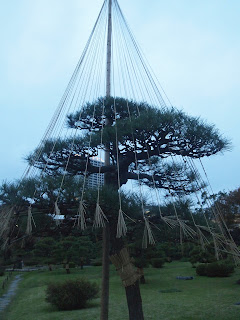Winter is coming in Japan.
In November, while autumn foliage reaches its glorious climax and winners are appointed at chrysanthemum festivals, in gardens, it is time to set up yukitsuri (雪つり), or 'snow suspenders': straw ropes that support branches preventing their breakage in case of heavy and wet snowfalls.
In November, while autumn foliage reaches its glorious climax and winners are appointed at chrysanthemum festivals, in gardens, it is time to set up yukitsuri (雪つり), or 'snow suspenders': straw ropes that support branches preventing their breakage in case of heavy and wet snowfalls.
Its origins are unknown but they may be related to the custom of tying the branches of apple trees laden with heavy fruits, developed during the late Edo period (1603-1868).
 The work requires a team of highly skilled workmen and begins with the preparation of the ropes and the calculation of the number and length needed for each tree. Then, ropes are fixed at the top of a bamboo pole that is erected near the trunk. From the top of the pole, which in the tallest trees is reached with a bold climbing, a man throws the
ropes to other men placed around the tree that knot them to the lowest branches or to bamboo canes arranged around the circumference of the tree. Another man checks
that ropes are correctly placed to create the traditional conical structure: balanced, effective and beautiful.
The work requires a team of highly skilled workmen and begins with the preparation of the ropes and the calculation of the number and length needed for each tree. Then, ropes are fixed at the top of a bamboo pole that is erected near the trunk. From the top of the pole, which in the tallest trees is reached with a bold climbing, a man throws the
ropes to other men placed around the tree that knot them to the lowest branches or to bamboo canes arranged around the circumference of the tree. Another man checks
that ropes are correctly placed to create the traditional conical structure: balanced, effective and beautiful.
 There are different techniques to tie the ropes, according to the type of tree, its size and conditions.
There are different techniques to tie the ropes, according to the type of tree, its size and conditions.
Evergreen trees are usually involved, as the weight of snow on the branches full of leaves is heavier and could easily break them. The ancient pines in the Kenroku-en Gardens, in the Ishikawa Prefecture in Central Japan, are famous examples but, in these gardens, even camellias, azaleas, acers and fruit trees are protected with these unusual umbrellas during the winter months. In Tokyo, this tradition is still carried on even if snowfalls are no more so heavy and dangerous.
Komo-maki, or 'straw mat wrapping' is another tradition related to winter. A straw mat is tied to the trunk so that insects could enter and find refuge in this warm space but not exit. At the end of winter, before the insects start to move, the mat is removed and burnt.
Useful and beautiful, yukitsuri and komo-maki are expressions of the fine art of Japanese gardens. Recalling the incoming winter.
TravelinaGarden, Tokyo, November 2015.
